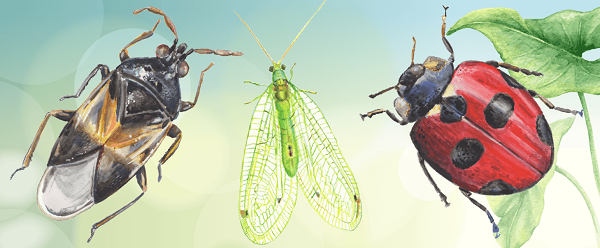When it comes to maintaining the health of the garden, many people automatically associate the presence of insects with the danger of pests. Although people tend to feel a certain rejection or apathy towards these animals, do not be in a hurry to resort to the insecticide.
This, in fact, should always be the last option, and as long as the crop is not in danger, sharing with nature can bring us great benefits in the long run, especially when it comes to certain species. The beneficial insects for the garden are classified mainly into two types: those that act as predators of harmful insects, thus acting as natural pest control, and those that are pollinating insects, favoring the fertilization of the plants in our garden. The proper use of these allies has a great impact on the health of the crop, allowing pests to be kept at bay and improving plant conditions without having to resort to chemicals. Do you want to learn more about beneficial insects for the garden?? Join us in this article?

Ladybugs
With more than 4,000 species of ladybugs, this sympathetic-looking insect is one of the most well-known beneficial garden insects. It is important to learn to recognize ladybug eggs and larvae so as not to damage them, as they are voracious predators that are especially skilled at devouring and hunting pests such as aphids and mealybugs. They do not harm the garden and, since they are larvae, they will spend the year that lasts their lives feeding on pests with a deceptive ferocity for the cheerful appearance of their shell.
Wasps
Wasps can be much more than a sting hazard and a call to panic for more than one. Depending on the species, they can act as pollinators or as pest control, being both predators of eggs and larvae and insects that parasitize their prey with their eggs. They are much less threatening than you tend to think and can be great allies against pests.
Praying mantis
The mantis is one of the biggest predators in the insect world. Their slender body and their fast and elegant movements make them easily recognizable and very striking. Their great ability and size allow them to feed on all kinds of insects, from larvae to caterpillars, moths and beetles.
Bedbugs
Not all bed bugs are a danger to humans or pets – some feed exclusively on other insects or mites. The dreaded aphids and whiteflies are among their favorite prey and give a good account of both the adult specimens and their eggs and larvae, using their maxillary stylet to feed.
Garden spiders
Species such as the tiger spider or the wolf spider are not insects but arachnids, but we include them as part of the group of “bugs” good for the garden. These spiders are totally harmless to the plants in our garden, although not so for the pests that dare to enter their domain. Some hunt using large webs while others use their agility and strength exclusively, but in any case, they are great allies of the crop. They should not be confused with the spider mite, one of the most common pests, which is actually a mite.
Earwigs
Also commonly called scissor bug or pick cutter, this order of insects is very easy to recognize by the striking scissors that its body seems to have at the end of it. They are one of the few insects that take care of their eggs after laying them. In this case, however, the benefits of earwigs are relative since they are insects that, in some cases, are omnivorous, which means that they can feed on plants if they do not find pests to devour. They are, thus, beneficial only in small numbers and can become a pest in itself.
Dragonflies
These unique-looking flying insects feed on insects, locating their prey thanks to their extraordinary eyesight. They especially prey on flies and mosquitoes. They lay their eggs in water, where they live from a few weeks to several years, after only living a few days.
Centipede
The so-called centipedes are, like garden spiders, highly effective and voracious predators in terms of pest control, keeping the population of these at bay in the garden.
Lacewings
These small green insects with large wings are also excellent hunters of small pests such as spider mites, thrips or mealybugs and therefore should be added to the list of beneficial insects for the vegetable garden, garden or terrace with potted plants. Lacewing is recognizable by its thin, slender body and antennae.
Firefly
Best known for their bioluminescent ability, fireflies are actually beetles whose larvae feed on all kinds of subsurface pests. Once, adult, they are much less voracious, feeding on pollen and nectar and being able to act as pollinators.




